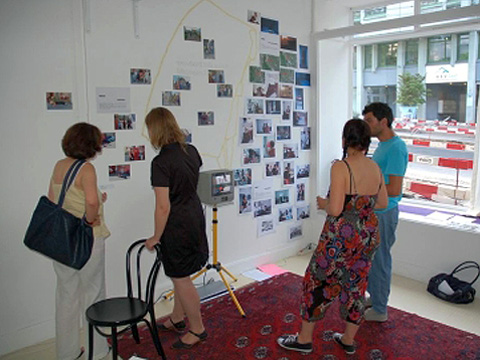Master Project
Anca Sinpalean
1 February 2011–11 June 2012
Romanian Cultural Institute in Venice, Artfoyer Cavigelli,Gemeinschaftszentrum Wollishofen
Part 1: Delia Popa/Part 2: Genia Loginova-Hünemörder, Mo Diener, Lada Nakonechna, Anuradha Pathak
The project “Fragmented Home” was structured as a series of events, at different venues. The first event took place in February 2010 with the exhibition “I Am Gustav von Aschenbach” at the Romanian Cultural Institute in Venice, followed by two other events centered around the newly founded art space in Zurich, artfoyer Cavigelli.
The artists chosen were mostly artists in residence in different ateliers in Zurich or abroad, who had the temporary experience of “migrating”, and were offered a “temporary home” within the scope of the project: Delia Popa, Lamia Moghazy, Genia Loginova-Hünemörder, Mo Diener, Lada Nakonechna, Anuradha Pathak.
We are living in an itinerant and time-compressing age, defined by the quintessential experience of movement around the globe. Globalization, migration, exile, relocation, on one side, and new technologies that facilitate instant real-time communication, on the other side, have changed the way we see ourselves and the way we interact with each other. Old notions like gender, sexuality, ethnicity, race, class and nationality give way to more heterogeneous and fragmented identity constructs.
As a result, our understanding of “home” as an identity searching space has changed. Our “homes” are fragmented, temporary, decentralized and even impossible to attain, mirroring our identity constructs. In place of the conventional conception of home as the stable physical center of the universe – a safe place to leave and return to – a far more mobile notion came into use: a home that can be taken along whenever one decamps.
For a world of travelers and journeymen, home comes to be found far more usually in a routine set of practices, in a repetition of habitual social interactions, in the ritual of a regularly used personal name. In a world more open than ever, where long term relationships are hard to maintain, people are always and yet never “at home”, they always struggle to find means to feel connected to a place, a group, a community. What elements help us feel “at home” in a different environment? How do we remodel our identity and thereby our definition of “home”? How do we fight against the spreading condition of homelessness?
Delia Popa’s project at the Romanian Cultural Institute in Venice was a complex undertaking, which involved performances and activist actions on the streets of Venice during the Carnival, interviewing the participants at the Carnival and inviting them in the artist’s studio constructed in the space of the gallery, where sketches and other materials were put on display. The internal mechanisms of “site-specific art making” were made visible by placing a monitor in the windows of the gallery, which showed the artist’s activities in “real time”.
Genia Loginova-Hünemörder, Mo Diener, Lada Nakonechna, Anuradha Pathak
The “headquarters” of the project were situated in the Artfoyer Cavigelli and the window of the Gemeinschaftszentrum Wollishofen. From here, the project expanded through actions and performances that embraced other areas of the neighborhood. The artistic interventions were all site-specific responses to the neighborhood of Wollishofen, raising questions about how we interact with each other within a community, about public versus private spaces, about recognizing the others not just in their stereotypical quality of being “workers“ or “artists“ or “immigrants“.
The form of the project was not structured as a classic exhibition, but more as a platform which tried to open up spaces for communicating and sharing ideas.Genia Loguinova-Hünemörder (RU) chose to make photographic portraits of the street workers on Albistrasse, in poster format, exhibited in the windows of the GZ Wollishofen. The artist gave thus a “face” to these anonymous workers, who were in fact temporary inhabitants of the neighborhood, portraying them in an heroic posture and light, real heroes that “bring our streets into shape“.
Swiss artist Mo Diener was engaged in performances and made workshops in and around the Artfoyer, while she actually lived in the gallery space for three days. Prior to the “living installation“, the artist asked the inhabitants of Wollishofen to lend her a few necessary things (matress, cutlery, cup etc.) for her temporary stay at the Artfoyer, things that she collected during the opening of the project, on the 11th of June, and brought into her temporary home.
Besides her installation “Die Welt gehoert nicht allen“ in the window of the Artfoyer, the Ukrainian artist Lada Nakonechna made a series of actions in public space. The artist encouraged passers-by to delimit their personal/private territory in public space, by drawing a chalk circle around themselves. The aim of the action was to investigate the resulting “geography” of the circles: if they intersect, if the participants include or exclude each other from their symbolic territories.
Anuradha Pathak, Indian artist in residence at the Rote Fabrik, made an installation in the Artfoyer consisting of a projection, photographs and drawings documenting the “Oliver” signatures in Wollishofen – the signatures of a person who intervened in public space by signing his name on benches, shields, bus schedules etc.
The project is realized in collaboration with the GZ Wollishofen and the Artfoyer Cavigelli and with the support from the Rote Fabrik, as part of the series of events celebrating its 30th anniversary.






